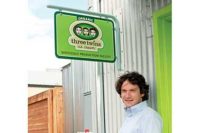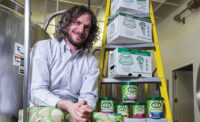Three Twins, the ice cream fixer-upper
Before he could make a pint of his Three Twins organic ice cream, owner Neal Gottlieb had to rehab the former Zurheide plant in Sheboygan, Wis.

Quart packages of Madagascar vanilla ice cream tumble onto a conveyor which leads to a metal detection device.

The versatile ice cream filler handles one lane of quarts and two lanes of pints. The two-lane filler can produce 120 pieces per minute, double the output of the plant in California.

A code is inkjetted on the bottom of the package. A scale (seen in the background) is used to make random checks of packages.

Quarts move into the shrink tunnel to be bundled in packs of three. One bundle consists of two packages with the lids on top flanking a package with a bottomfacing lid. Another bundle has the opposite configuration. This helps in building pallets efficiently.

Bundled packages are conveyed into the hardening room, where pallets are built by hand. Refrigerated trucks arrive several times a week to load pallets and take them to a warehouse in Illinois.

Three Twins Ice Cream bought the plant used by Zurheide, which went out of business in 2008. Improvements to the building include beams in the basement to shore up the first-floor mix room (shown) and packaging room, sanitary tile and a covered milk receiving bay.







Neal Gottlieb, the founder of Three Twins Ice Cream, needed more capacity to keep up with demand for his organic ice cream. His facility in Petaluma, Calif., was maxed out. Adding shifts was not feasible. Gottlieb bid the work to co-packers but said their quotes were “sky-high” and the quality of the test runs was a “disaster.”
In 2013, he caught wind of an auction in Sheboygan, Wis. Equipment in the Zurheide Ice Cream plant, which closed in 2008, was up for auction. The building was probably going to be razed. At the 11th hour, Gottlieb bought the equipment and the real estate. Upon closer inspection, Gottlieb realized that before he could make ice cream, he had to rebuild the ice cream factory.
From September 2013 to August 2014, Gottlieb made improvements to the three-story, 15,000-square-foot property. He shored up the first floor and re-tiled it, built a milk receiving bay that met Wisconsin dairy codes, overhauled the freezer and made other investments. By August 2014, the plant was making ice cream.
Doing business in the Midwest
During that time, Gottlieb learned about the costs of doing business in the Midwest. He said that because real estate prices are modest in Sheboygan (a nice house can cost less than $100,000), he expected labor costs would be, too.
“The cost of living is so much lower, I thought the wages would be lower,” he said.
They aren’t, as he found out. Sheboygan County is home to good-paying manufacturing jobs. The top employers in the county are Kohler, Bemis and Nemak. Food manufacturers include Sargento, Johnsonville Sausage and Dairy Farmers of America. Unemployment is low. Dane Checolinski, the director of the Sheboygan County Economic Development Corp., said there are 3,000 unfilled jobs in the area. That puts pressure on wages. Entry level wages in the dairy industry are $17 to $18 an hour compared to $14 for business in general, Checolinski said.
The region is supportive of manufacturing in general and of food processing specifically. Glacier Transit and Storage, for example, has added refrigerated warehouse space in the county in the last two years. The city of Sheboygan welcomed Three Twins. It loaned the company $120,000 over 10 years to buy the building and equipment.
Since its founding in 2005, Three Twins now sells its pints and novelties in every state in the union. About 5,000 stores carry the company’s products, Gottlieb estimated. (See related article)
He started making ice cream in a 560-square-foot scoop shop in San Rafael, Calif. He used a 20-quart batch freezer. He was the only employee. As his company grew, he opened a manufacturing facility in Petaluma in 2010. The growing sales of the company put a strain on the ice cream plant, but Gottlieb wasn’t specifically seeking to purchase another plant.
“We needed a solution and it presented itself in the form of this facility that we could buy,” Gottlieb said. “It ended up taking a lot longer to get it actually into production, and costing a lot more money than was expected. But in the long run it’s been really beneficial to the company.”
Organic ingredients and a simple recipe
Gottlieb said he is asked why his ice cream tastes so good. The answer is “simplicity.”
“It’s really easy to make great ice cream,” he said. “You start with good ingredients, and you don’t muck it up. So it’s milk, cream, sugar and eggs. It’s really simple.”
Three Twins does not use artificial flavorings or colorings, stabilizers, corn syrup or fractionated milk products.
“We don’t try to fake it. I don’t think you can fake people’s taste buds. And nowadays, more and more people are reading labels.”
The retail price of a pint of Three Twins ice cream is about $6. That’s a reflection of the ingredients the company buys.
“First and foremost, everything has to be organic,” Gottlieb explained. “As Three Twins has grown up, we seek to have more information about our sourcing. We stick with suppliers that we know” and that are sourcing in an ethical manner, he said.
Fair Trade suppliers charge more for their ingredients because they meet a higher standard as far as living and working conditions of the farm workers, Gottlieb said. Sugar, vanilla and some chocolate ingredients are certified Fair Trade. Three Twins’ vanilla supplier had not been sourcing an organic fair trade version until Gottlieb asked for it. Now it does, and the supplier sells the vanilla to other food manufacturers as well.
Touring the Three Twins plant
On the day of Dairy Foods’ visit, the plant was making quarts of Madagascar vanilla ice cream. Nate Dehne, who worked in the Zurheide’s plant, now manages the Three Twins facility. Cory Koll, the mix leader, also worked at Zurheide.
Milk from a single Wisconsin dairy farm arrives by tanker at the receiving bay. Samples are tested in the upstairs dairy lab, which is one of the approved domestic milk laboratories on the Food and Drug Administration’s Interstate Milk Shippers list. After passing inspection, the milk is pumped to one of three tanks. Supplemental organic cream arrives in totes from Wisconsin dairy farmers, including Westby Co-operative Creamery.
In the mix room, milk, cream, sugar, powders and frozen egg yolks are liquefied. The mixture is vat-pasteurized in a water-jacketed 600-gallon vessel. Vat pasteurization is gentler than steam-treating, Gottlieb said. (When a recipe calls for chocolate, dark chocolate pieces are melted until liquid in a separate vat.)
The mix is pumped to flavor tanks and then to a filler that can handle a variety of formats and products. The equipment fills pints and quarts and can be converted to make cones and sandwiches. Quarts roll through in a single lane, pints in double lane and cones in three lanes. Other formats include 10-quart containers and 5-liter gelato pans. When a recipe calls for inclusions, a varigator is set up on the line.
The two-lane filler can produce 120 pieces per minute. The Sheboygan plant is twice as fast as the one in Petaluma.
As the quarts are filled, they fall down a conveyor belt and are turned upside down. They pass through a metal detector and then an ink-jetting machine that prints a code date on the bottom of the package. Then the packages are sent to a shrink tunnel and bundled in shrink wrap. They are bundled with two packages up and one down and two down and one up. This makes the bundles easier to stack. In the freezer, an employee grabs the bundles off the line and stacks them on racks to harden. Once the company makes a sufficient number of pallets, a trucking company takes them to a cold storage warehouse in Illinois.
Cones and sandwiches
A new product for Three Twins is the organic sundae cone. Gottlieb said his company is the first to make an organic version. The sundae cone is sprayed with chocolate and filled with Madagascar vanilla ice cream. Then it’s topped with chocolate and peanuts. Some of the chocolate spray collects in the bottom of the cone and forms a little nugget in the tip.
There are two versions of the ice cream sandwich. The traditional sandwich has vanilla ice cream between two chocolate wafers. The other is lemon ice cream between vanilla wafers.
Three Twins also developed dry organic sugar cones that are co-packed for the company. Consumers who don’t live near a Three Twins scoop shop can buy a pint of ice cream and a 12-pack of cones at retail, take them home and scoop their own treat.
The co-packer Three Twins had been using stopped making organic novelties. With the purchase of the plant in Wisconsin, Three Twins brought sandwich production in-house. It bought the co-packer’s equipment and installed it in Sheboygan.
The plant manufactures ice cream five days a week on one shift. The company can accommodate increased demand by adding another shift. There are about a dozen employees in Sheboygan, with about eight or nine on the production floor. When the plant produces cones, a few more people help out. The plant also brings in temporary workers during the summer when ice cream demand increases. In California, the plant in Petaluma runs with about 15 employees. The office staff is about 14. Counting part-time help in the scoop shops, the company payroll is about 80 individuals, Gottlieb said.
Looking to the future
Although the Wisconsin plant was not move-in ready when Gottlieb bought it, and required significant improvements, the investment will pay off in the long term. First, the company has control over the quality and the costs (something co-packers were not able to do). Second, as demand for ice cream grows, Three Twins can add additional shifts without having to buy additional equipment or seek a third location.
On the consumer side, Three Twins will ride the wave of increasing interest in organic and clean-label foods. But as Gottlieb knows, a food has to taste good, too. In this case, Three Twins has the best of both worlds.
Three Twins Ice Cream
Sheboygan, Wis.
Size of plant: 5,000 square feet of manufacturing; 15,000 square feet total
Date purchased: September 2013
Date opened: August 2014
Products and formats: Organic ice cream in pints and quarts; sandwiches; cones
Production shifts and employees: 1 shift, five days a week; 8 to 9 employees
Equipment: Raw tanks, vat pasteurizers, liquefiers, flavor tanks, freezer, pint and quart filler, cone filler, sandwich maker, inspection equipment

Looking for a reprint of this article?
From high-res PDFs to custom plaques, order your copy today!













